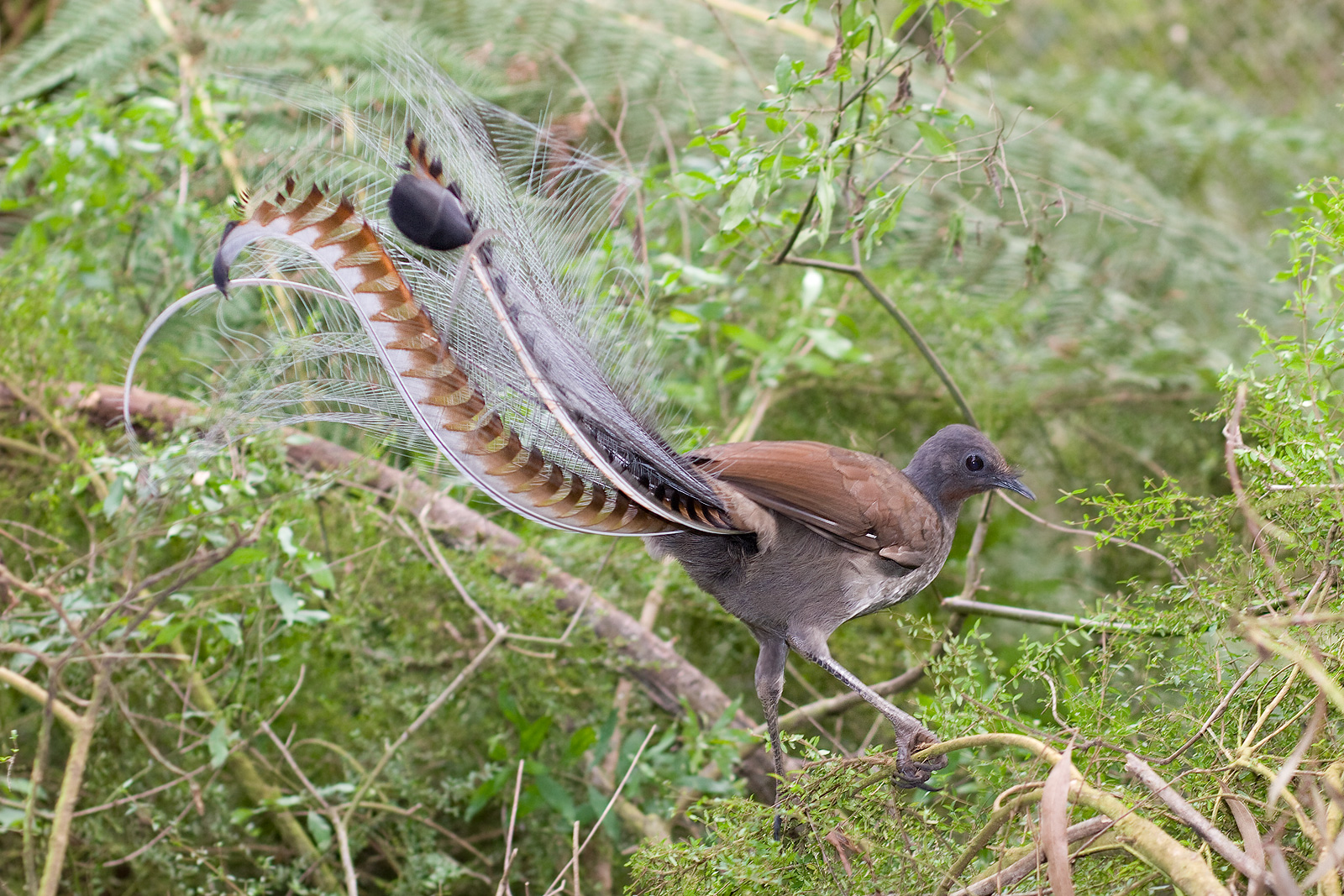Scientific Classification
- Genus: Menura
- Family: Menuridae
- Species: There are two species of lyrebirds:
- Superb Lyrebird (Menura novaehollandiae) – found in southeastern Australia.
- Albert's Lyrebird (Menura alberti) – found in subtropical rainforests of northeastern New South Wales.
Physical Description
- Size: Lyrebirds are medium-sized birds, with lengths ranging from about 70 cm (27 inches) to 1 meter (39 inches), including their long, impressive tail feathers.
- Coloration:
- The Superb Lyrebird has an overall brownish and grayish body, with striking features such as a white eyebrow and a crest on its head.
- The Albert's Lyrebird, a rarer species, has a more vibrant plumage with a chestnut-brown body and a darker tail.
- Tail Feathers: The most noticeable feature of the lyrebird is its long, elegant tail, which is shaped like a lyre (a musical instrument) and is used in elaborate courtship displays. The tail feathers are symmetrical and are made up of iridescent feathers, which the male raises and spreads during mating rituals.
Mimicry and Vocalizations
- Mimicry: Lyrebirds are famous for their incredible mimicry skills. They can imitate a wide range of sounds, including:
- Other birds' calls: They can mimic various bird species, including kookaburras, parrots, and hawks.
- Human-made sounds: Lyrebirds are capable of replicating mechanical and man-made sounds, such as chainsaws, camera shutters, car alarms, and even mobile phone ringtones.
- Environmental sounds: They can mimic natural sounds like the rustling of leaves, running water, or even a dog’s bark.
- Purpose of Mimicry: The primary purpose of the lyrebird’s mimicry is for courtship. Male lyrebirds use their diverse vocal repertoire to attract females, demonstrating their fitness and ability to produce a complex range of sounds. Additionally, their elaborate tail display adds to their appeal.
- Vocal Performance: The male lyrebird performs an elaborate vocal display while spreading its tail in a fan-like shape, often accompanied by a dance-like display. The vocal performance, combined with the tail display, makes it a visually and auditorily stunning experience for anyone fortunate enough to witness it.
Habitat and Distribution
- Habitat: Lyrebirds are typically found in dense forests and rainforests of southeastern and eastern Australia. They favor areas with dense undergrowth and a combination of trees and shrubs, which provide shelter and food.
- Range: The Superb Lyrebird is found in the southern and eastern parts of Australia, including areas like the Great Dividing Range and Tasmania. The Albert’s Lyrebird, on the other hand, is confined to a smaller, more specific region in northeastern New South Wales.
Diet
- Omnivorous: Lyrebirds are omnivores and primarily feed on insects, worms, and small invertebrates that they find in the forest floor. They forage by scratching through the leaf litter with their feet to uncover food.
- Occasionally feed on seeds, fruits, and small plants, depending on the availability of food in their environment.
Reproduction and Behavior
- Breeding Season: The lyrebird's breeding season typically occurs in spring and early summer. During this time, males engage in vigorous courtship displays, which include vocal performances and the showing of their lyre-shaped tails.
- Nesting: The female lyrebird builds a deep cup-shaped nest on the forest floor, where she lays one or two eggs. Both parents take part in feeding the young after they hatch.
- Incubation: The female incubates the eggs for around 5–7 weeks, and once hatched, both parents care for the chicks, feeding them insects and other small food.
Conservation Status
- Superb Lyrebird: The Superb Lyrebird is not currently considered threatened and is classified as Least Concern by the International Union for Conservation of Nature (IUCN). The population of this species is stable due to its broad distribution across southeastern Australia.
- Albert’s Lyrebird: The Albert's Lyrebird, on the other hand, is classified as Near Threatened due to habitat loss and degradation caused by logging and land development. Conservation efforts are in place to protect its habitat in the rainforests of northeastern New South Wales.
Interesting Facts
- Tail Feathers: The male’s tail feathers are often used to create intricate, symmetrical shapes during mating displays. The tail feathers can grow up to 1 meter in length, making them quite spectacular when fanned out.
- Cultural Impact: The lyrebird is iconic in Australian wildlife and culture. Its remarkable vocal abilities have inspired a variety of creative works, and it is often depicted in art, literature, and media.
- Research on Mimicry: The lyrebird’s exceptional mimicry has been the subject of research for years. Its ability to learn new sounds and incorporate them into its repertoire makes it a valuable subject of study for those interested in animal behavior and communication.
Conclusion
The lyrebird is an extraordinary example of nature's creativity and adaptability. With its impressive vocal range and stunning physical appearance, it captivates both birdwatchers and scientists alike. As a symbol of Australia’s rich biodiversity, the lyrebird’s ability to mimic and perform continues to astound and inspire. However, conservation efforts for species like Albert’s Lyrebird are essential to ensure that these unique creatures continue to thrive in their natural habitats.
Would you like to learn more about how lyrebirds mimic specific sounds or their role in Australian ecosystems? Let me know!
"This Content Sponsored by Buymote Shopping app
BuyMote E-Shopping Application is One of the Online Shopping App
Now Available on Play Store & App Store (Buymote E-Shopping)
Click Below Link and Install Application: https://buymote.shop/links/0f5993744a9213079a6b53e8
Sponsor Content: #buymote #buymoteeshopping #buymoteonline #buymoteshopping #buymoteapplication"


.jfif)


No comments:
Post a Comment